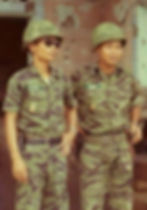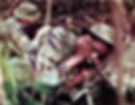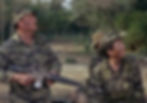Behind Enemy Lines: The Rise and Impact of Tigerstripe Camouflage
- Pete Palazzolo
- Oct 24, 2024
- 4 min read

The Vietnam War was a turning point in the development and use of military camouflage patterns. As U.S. forces engaged in jungle warfare, traditional uniforms such as OD Green (Olive Drab) proved inadequate against the dense foliage and varied terrain. In response, several camouflage patterns were adopted during the war, including Tigerstripe, which became one of the most significant and recognizable. Alongside it, patterns like ERDL (Engineer Research and Development Laboratory) played a role, but Tigerstripe stood out as a symbol of elite units and unconventional warfare.
The Birth and Significance of Tigerstripe Camouflage
Tigerstripe camouflage was born out of necessity in the early 1960s. As American forces collaborated with the Army of the Republic of Vietnam (ARVN), they noticed the need for better concealment in the dense jungles. Drawing inspiration from the French "Lizard" camouflage, which had been used during the First Indochina War, Vietnamese designers created Tigerstripe. The pattern featured bold, irregular horizontal stripes in black, green, and brown, mimicking the play of light and shadow in the jungle. This design helped break up the human silhouette, making soldiers harder to detect.

Unlike other patterns, Tigerstripe was not mass-produced in the United States but was instead tailored locally in Vietnam. As a result, there were numerous variations of the pattern, depending on where it was manufactured. These differences often included changes in color intensity, fabric quality, and stripe width. Some of the most common variants included the "golden" Tigerstripe, which had lighter, almost yellow tones, and the "jungle" Tigerstripe, which used darker hues for denser foliage.
Tigerstripe gained its notoriety through its association with elite units. It was primarily worn by U.S. Special Forces, including Navy SEALs, Green Berets, and Long-Range Reconnaissance Patrols (LRRPs), who operated in some of the most dangerous areas of Vietnam. These soldiers often worked deep behind enemy lines, carrying out high-risk missions that required absolute stealth. Tigerstripe became a symbol of their expertise and fearlessness, contrasting with the standard OD Green uniforms worn by regular troops.
Other Patterns Used in Vietnam
Though Tigerstripe became synonymous with Special Forces, it was not the only camouflage pattern used during the war. The ERDL pattern, developed by the U.S. Army's Engineer Research and Development Laboratory in the early 1960s, was also used extensively. It featured a mix of four colors—green, brown, black, and beige—designed to blend into the jungle. ERDL came in two variants: the "Lowland" version with more green and the "Highland" version with more brown. By the late 1960s, ERDL uniforms were worn by U.S. Marines and some Army units, especially in regions where standard OD Green was less effective.
OD Green uniforms continued to be the standard issue for many regular units throughout the war. Although they lacked the intricate design of camouflaged patterns, they were easier and cheaper to produce. However, in the thick jungles of Southeast Asia, where vegetation and shadows created complex environments, OD Green was often outmatched by more specialized camouflage like Tigerstripe and ERDL.
The Enduring Legacy of Tigerstripe

After the Vietnam War, Tigerstripe's legacy persisted both within and outside military circles. For many veterans, it became a symbol of their service, and it was not uncommon to see Tigerstripe jackets, hats, and gear being worn in civilian life. The pattern's cultural significance also extended into popular culture, appearing in films, streetwear, and as a fashion statement for those drawn to its historical associations.
In the decades that followed, Woodland Tigerstripe, a hybrid of the original Vietnam Tigerstripe and the U.S. military's M81 Woodland pattern, emerged. This version retained the distinctive jagged stripes but incorporated the four-color palette of Woodland, making it suitable for more temperate environments. This adaptation allowed the pattern to continue its military and tactical use while appealing to a broader range of collectors, outdoorsmen, and fashion enthusiasts.
Variations and Modern Use

Tigerstripe itself came in many variations during its time in Vietnam. As local manufacturers produced the uniforms, changes in fabric and color intensity were common. The "golden" Tigerstripe was known for its lighter, yellowish tones, while darker variants were often referred to as "jungle" Tigerstripe. This inconsistency added to its allure for collectors and historians, as no two uniforms were exactly the same. Although it is no longer an official issue in the U.S. military, Tigerstripe continues to be worn by some specialized forces around the world. Its reputation for effectiveness in jungle and forested environments has led to its adoption by various military and paramilitary units globally, as well as by law enforcement in certain countries.
Conclusion
Tigerstripe’s role in the Vietnam War made it one of the most iconic camouflage patterns of all time. It symbolized elite forces, jungle warfare, and the changing nature of military combat in the mid-20th century. While other patterns like ERDL and OD Green were also used, Tigerstripe’s unique design, multiple variations, and cultural significance have ensured its place in military history. Today, its legacy lives on, both in modern tactical gear and as a symbol of courage, innovation, and resilience on the battlefield.


